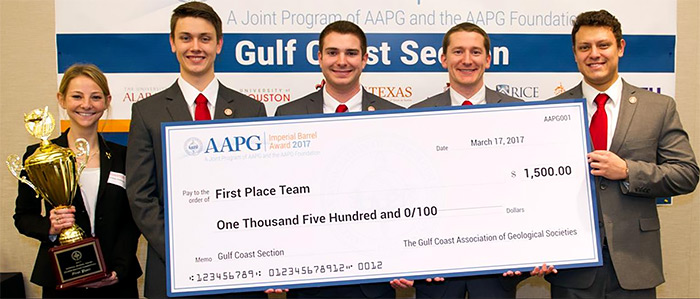UH Last Won in 2007, Has Been Four-Time, Top Three Finisher
A team of five UH Ph.D. and M.S. graduate students from UH’s Department of Earth and Atmospheric Sciences won first place in the Imperial Barrel Award Program (IBA) of the American Association of Petroleum Geologists (AAPG) Gulf Coast Section competition. The UH team competed on March 17 at the Anadarko building in The Woodlands.
 The winning UH team, from left: Delaney Robinson (Ph.D.), Walter Reed (M.S.), Eric
Lunn (Ph.D., Team Captain), Andrew Steier (M.S.), and Leiser Silva (M.S.). The dataset
they presented was the Taranaki basin, New Zealand.AAPG’s IBA Program is an annual prospective basin evaluation competition for geoscience
graduate students from universities around the world. University teams compete to
win scholarship funds for their geoscience department and the international recognition
that comes from competing in or winning the competition. The UH team received a check
for $1,500 which will be used in the coming year to support the activities of the
AAPG student chapter at EAS: www.uh.edu/nsm/earth-atmospheric/student-organizations/
The winning UH team, from left: Delaney Robinson (Ph.D.), Walter Reed (M.S.), Eric
Lunn (Ph.D., Team Captain), Andrew Steier (M.S.), and Leiser Silva (M.S.). The dataset
they presented was the Taranaki basin, New Zealand.AAPG’s IBA Program is an annual prospective basin evaluation competition for geoscience
graduate students from universities around the world. University teams compete to
win scholarship funds for their geoscience department and the international recognition
that comes from competing in or winning the competition. The UH team received a check
for $1,500 which will be used in the coming year to support the activities of the
AAPG student chapter at EAS: www.uh.edu/nsm/earth-atmospheric/student-organizations/
The UH team consisted of five EAS Ph.D. and M.S. graduate students: Delaney Robinson (Ph.D.), Walter Reed (M.S.), Eric Lunn (Ph.D., Team Captain), Andrew Steier (M.S.), and Leiser Silva (M.S.). The team’s faculty advisors include Paul Mann, John Castagna, Julia Wellner and Kurt Rudolph. Industry advisors include Mike Liebelt and Mark Richardson.
In this global competition, university teams analyze a dataset (geology, geophysics, land, production infrastructure and other relevant materials) in the eight weeks prior to their local competition. Each team delivers their results in a 25-minute presentation to a panel of industry experts. The dataset the UH EAS team presented was the Taranaki basin, New Zealand.
Students have the chance to use state-of-the-art technology on a real dataset, receive feedback from an industry panel, impress potential employers in the audience, and win cash awards for their school. The judges select the winning team on the basis of the technical quality, clarity and originality of presentation.
The program is rigorous and contributes to AAPG's mission of promoting petroleum geoscience training and advancing the careers of geoscience students. Originated in 2007, the program currently involves 455 universities in 61 countries.
The other nine teams involved in the Gulf Coast Sectional Competition were: University of Texas Austin, Texas A&M University, Rice University, Auburn University, Stephen F. Austin State University, Mississippi State University, University of Alabama, University of Louisiana-Lafayette, and Louisiana State University.
When the IBA Program began in 2007, UH was one of the first schools to get involved in the new program and won the Gulf Coast Section that year, at that time only a few schools were involved. Prior to 2012, this was the last time UH placed in the completion.
All teams that place first in their sectional competition will advance to a final competition to be held at the Annual AAPG Convention on Saturday, April 1.
History of IBA at EAS Dept (2012-present)
- 2012 - Gulf Coast 3rd PlaceFinish: www.uh.edu/nsm/earth-atmospheric/news-events/stories/2012/0403_ibaCompetition.php
- 2013 - Gulf Coast 3rd Place Finish: www.uh.edu/nsm/earth-atmospheric/news-events/stories/2013/0424_aapgAward.php
- 2014 - Gulf Coast 3rd Place Finish: www.uh.edu/nsm/earth-atmospheric/news-events/stories/2014/0325-iba-competition.php
- 2015 - Did Not Place: www.uh.edu/nsm/earth-atmospheric/news-events/stories/2015/0422-iba-comp.php
- 2016 - Gulf Coast Second Place Finish: www.uh.edu/nsm/earth-atmospheric/news-events/stories/2016/0422-barrel-award.php
- 2017 - Gulf Coast First Place Finish: March 17, 2017
More information on IBA program and photos of other winning sectional teams to compete at AAPG Meeting in April: http://iba.aapg.org/